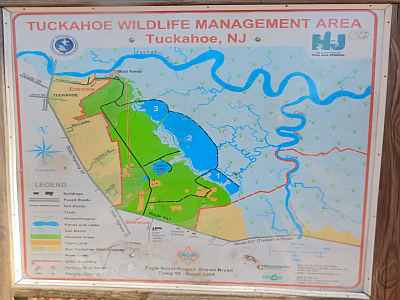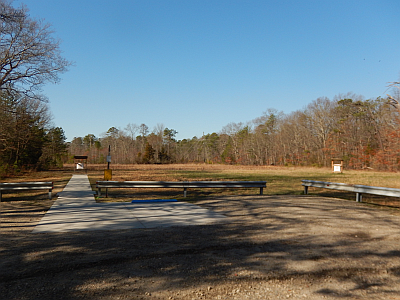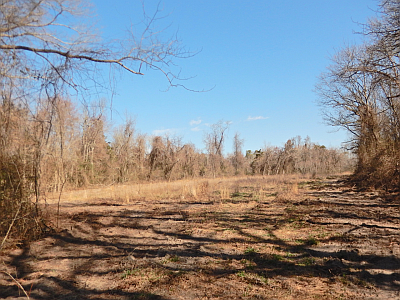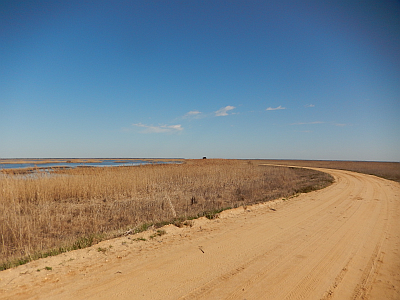New Jersey Butterfly Club
A chapter of the North American Butterfly Association (NABA)
Lester G. MacNamara (Tuckahoe) Wildlife Management Area
by Jack Miller
County: Cape May.
Municipality: Upper Township.
Directions: The best way to find MacNamara WMA (known to all as “Mac”) is to search for Levari’s Seafood and American Grill 1291 NJ-50, Woodbine, NJ 08270. The Grill is located at the intersection of Route 50 and Tuckahoe Road. From Levari’s, travel ESE on Tuckahoe Road for 0.3 miles until you see the MacNamara entrance (marked by a sign) on the left. To enter MacNamara at its NW corner, head south on Rt. 50 from Mays Landing, and immediately after crossing the Tuckahoe River, enter the WMA by making a left onto Mosquito Landing Road.
Here is a map showing the roads around the Mac.
Parking: No paved parking is available, but there are plenty of places to pull over and several locations where multiple cars can park. The archery area can accommodate at 6-8 vehicles and is a fine place to park to access the powerline.
Nearest sizable town: Marmora is reached by heading east on Tuckahoe Road for 4.8 miles. To stay on Tuckahoe Road, you need to turn right at the Church of the Resurrection/Saint Maximilian Kolbe Parish. About 0.1 miles down the road is Wayside Village where there is a pharmacy and the Village Kitchen, an informal place to eat. Tuckahoe Road ends at the Route 9 light. Turn left, and immediately on your left is a Wawa for food, gas, and bathrooms. Ocean City is 2.5 miles from the Wawa.
Habitats: MacNamara is part of the 12,377-acre Tuckahoe Wildlife Management Area (which includes the Corbin City section north of the Tuckahoe River). Mac is bordered to the north by the Tuckahoe River and to the east by extensive salt marsh. The woods are rich mix of upland and wetland areas that support both deciduous trees and pines. A few openings within the forest are burned, plowed, and planted each year. There is a lake in the center of the WMA and three large impoundments that are managed for migratory birds along the eastern edge of the site. A powerline cuts through MacNamara from north to south.
Maintained/Marked trails: The WMA has no maintained/marked trails.
Restrooms: None.
Picnic tables: None.
Notable species: More than 60 butterfly species have been reported from Mac in the past 10 years. With luck, you might see one of the area’s notable explosions of Salt Marsh Skipper (331 on 6/24/20), Henry’s Elfin (201 on 4/6/20), Red-banded Hairstreak (57 on 8/29/16), or American Snout (31 on 3/9/20). In May Little Wood Satyrs can easily be seen, and from June to August Red-spotted Purples, Black Swallowtails, Aaron’s Skippers and Broad-winged Skippers are numerous.
Best time to visit: Butterflies have been seen at Mac in all 12 calendar months. By February, Eastern Commas, Question Marks, Mourning Cloaks, Red Admirals and Snouts become active on warm days. By March and April, they are joined by azures and Henry’s, Pine, and Brown elfins. Many butterfly species fly throughout the summer. In July and early August the biting flies may make it impossible to walk the dikes, but the woods and fields will be OK to explore with the help of bug spray and long sleeves. In the fall (mid-September to early November is best), northbound migrants such as Long-tailed Skipper, Ocola Skipper, and Cloudless Sulphur are common, and at times hundreds of southbound Monarchs and Common Buckeyes can be seen.
Exploring MacNamara WMA: Cruise, stop, and walk, as butterflies can be found everywhere. Most months of the year it is productive to walk the powerline, and this is now the remaining location for a once-plentiful population of Northern and Southern cloudywings. Mac is excellent for birding all year round. May is the peak month for migrating woodland birds. In the fall, the impoundments’ water height is regulated to attract thousands of swallows and numerous species of migrating shorebirds. Peregrine Falcons, Coopers Hawks, and Bald Eagles are commonly seen. The impoundments hold many species of waterfowl from fall to spring and are the haunt of wintering Northern Harriers and Red-tailed Hawks. In February and March migrating ducks of all kinds raise the number of waterfowl present into the thousands.
Special precautions: Take note of NJ hunting seasons, as waterfowl, deer and small game are all hunted at Mac. This is coastal South Jersey, so besides 4 species of ticks, we have greenheads, deerflies, no-see-ums, and mosquitos. Long pants, long-sleeved shirts, boots, and bug spray are recommended!
You might also want to visit: If you are interested and capable of bushwhacking, there is a fantastic stand of huge Atlantic White Cedars at the extreme SE corner of Mac—but be careful, as it is very easy to get lost there. Also excellent for butterflies (and of course birds) are Forsythe NWR (which has a Friend's of Forsythe support group) 35 minutes to the north, and Cape May Point State Park 35 minutes to the south.
Further information about MacNamara WMA is available.
To view a larger map, click on 'View larger map' icon in upper right hand corner. (Tip: The satellite view may also suggest good potential butterfly habitat to explore.)

MacNamara (Tuckahoe) WMA Entrance Sign.

Wildlife Management Area Map.

Archery Range Parking.

Power Line Corridor.

One of Mac's Meadows.

Road Through The Refuge.

Road Along The Dike.